Pros
Cons
Tour & Design
The Audio-Technica ATH-A700 headphones are a pair of over-ears with big ear cups and a long cord.
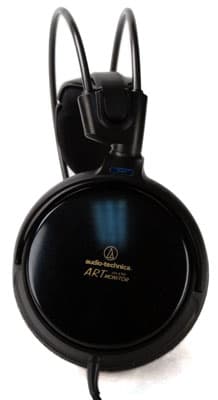
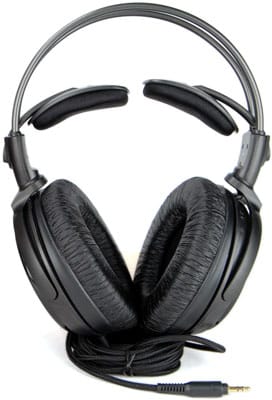
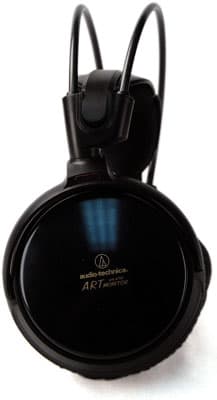
If you couldn't tell from these pics, the band is very strange. It's comprised of two rigid plastic rods and two pads. The pads are the only part that rests atop your head. They're attached to the cups with springs. You simply put on the headphones and they conform to your head as best they can.
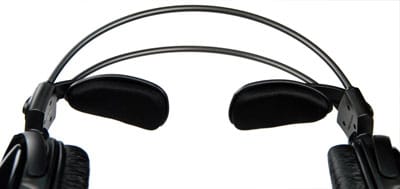
***This is the head band, which isn't so much a band as it is an elaborate head
clutching device.***
The cord extends down from the left ear cup, runs through quite a few feet of sweater-wearing cable (the cloth weave will protect the cord from dangers), and ends in a standard 1/8-inch plug.
The only things you'll find in the ATH-A700s' box are the headphones themselves and a 1/4-inch adapter.
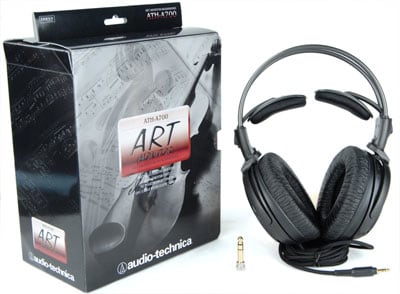
There really aren't any glaring durability issues with the ATH-A700s. The cord is very durable. The cord guards are substantial and their cloth weave will both help stave off the various ills that typically befall cables. The headphones themselves have some moving parts, which is a bit of a durability issue. The band is very, very flexible, however, which will help avoid breakage. We were impressed with the ATH-A700s design.
We think this particular design aesthetic is a bit silly. If you're into audio and can pull it off, then consider yourself one of the lucky people. Really, the ATH-A700s don't look bad on their own, but they're just so big. These headphones will make anyone's head look four sizes too small.
This being said, the overall look is good. These headphones don't have any fluorishes, but they look sleek in their simplicity. If it weren't for their size and the band creating a mini orbit around our scalp, we would've given them more points. Feel free to award bonus points if you're young, alternative, and really want everyone to know you're serious about your audio.
Performance
About our testing:
For more information on our tests, read this article.
**Frequency Response** *(2.07)* [

](https://www.reviewed.com/headphones/content/How-We-Test-149.htm#Frequency_Response)
How the test works:
In this test, we play a range of frequencies through the headphones, into HATS's ears. HATS records the output, then sends it to SoundCheck, which compares the sound wave to the original. The graph below depicts how loudly each channel emphasized each frequency. The green line is the left ear cup; the red line is the right ear cup. The two dotted lines are the limits we score based on. If you'd like to read more information on this test, click the orange information icon to the right of this section's title, or underneath the graph at right.
What we found:
The ATH-A700s didn't have the most stellar frequency response. Halfway between the 1kHz and 10kHz both channels are significantly underemphasized for a handful of frequencies, then spike back up for a moment before dipping down again. The left channel is particularly underemphasized, straying almost 20dB away from the lower limit. After 10kHz and a brief stay within the limits, it drops down again. Typically where we see headphones go wrong on this test is by over-emphasizing certain frequencies, typically the bass or drums. The ATH-A700 actually has a fairly even bass response, but they drastically under-emphasize the drums (the second downward plunge is about 7kHz, which is the attack on most drums).
How the Audio-Technica ATH-A700 compares:
Many of the comparison headphones also had a bad frequency response graph. The QC3s, for example, followed a similar trend, but fell further off the bottom limit. It seems to be a trend among over-ears to have a bit of a sudden de-emphasis towards the 7kHz range: the Ultrasone HFI-2200, QC3, and SR60 all have some sort of valley in this area. The Pioneer SE-A1000 headphones, which are similar in form factor to the ATH-A700s, actually had a very good score on this test, staying within the limits the entire time. If you like the ATH-A700s' form factor, but want a more even kiel to your sound, consider the SE-A1000s.

](https://www.reviewed.com/headphones/content/How-We-Test-149.htm#Frequency_Response)
How the test works:
For our distortion test, we again play a frequency sweep through HATS. This time, we compare the headphones' performance to the original sound wave, noting any differences between the two. These differences are distortion, which simply indicates the sounds you're hearing aren't exactly what you're supposed to be hearing. In the graph below, the level of distortion is measured as a percentage. Anything over 3% is noticeable. Again, the green and red lines represent the left and right channels respectively. Also, like all our graphs, the extreme left and right sides aren't totally accurate and therefore aren't scored. We show this data anyway, since they're good indicators of trend. For more information on this or any other test, click the orange information buttons.
What we found:
The ATH-A700 has remarkably little distortion. The graph is a bit bumpy along the zero line, but it never crosses 0.5% distortion at any point. If you're a finnicky audiophile who hates distortion, the ATH-A700s are definitely a pair of headphones to consider.
How the Audio-Technica ATH-A700 compares:
The ATH-A700 has some stiff competition in the comparison headphones, but it was only bested by the Sennheiser HD 555. It narrowly edged out the Bose QC3s, and thoroughly trumped the other three. The HD 555 and QC3 actually use our old graph format, which starts at 20 Hertz instead of 100, so ignore the rocky starts to those graphs (we don't score on that area because we can't get results that are precisely accurate). Really, while the ATH-A700's graph is slightly bumpier than the HD 555s' and slightly less bumpy than the QC3s', all three headphones are outstanding. The ATH-A700 has impressively little distortion.

](https://www.reviewed.com/headphones/content/How-We-Test-149.htm#Tracking)
How the test works:
The tracking test measures how balanced the ear cups are. This test again plays a frequency sweep. This time we're measuring the decibel output of each channel. On the graph below, the blue line represents each channel's volume, relative to the other channel. If the blue line stays at the zero mark, then the two channels are playing at even decibel levels. If it raises above the zero line, it means the left channel is louder; if it falls below the zero line, the right channel is louder.
What we found:
The ATH-A700s didn't have the best tracking. The graph started out fine, only straying about 2dB away from the zero line. At about 500 Hz, however, the volume shifts suddenly to the right. After this swing, the line levels off for a bit, but becomes rocky around the 2kHz line. At about 7kHz there's a significant swing from right to left. This, coupled with the weird frequency response, might make drums sound strange.
How the Audio-Technica ATH-A700 compares:
The ATH-A700 didn't do so well on this comparison. Many other headphones get a bit crazy towards the 7kHz range and up, but they have a more balanced response up until that point. Although the ATH-A700 headphones dont' have the best tracking we've ever see, they could've ben a bit more even-handed.
**Maximum Usable Volume** *(9.31)* [

](https://www.reviewed.com/headphones/content/How-We-Test-149.htm#Maximum_Usable_Volume)
How the test works:
This test is comprised of a series of distortion tests at different volumes. What we're looking for is the maximum decibel output the headphones can achieve while remaining below 3% distortion. Again, once distortion hits 3%, it starts to take a major toll on sound quality.
What we found:
The ATH-A700s were capable of 116.37dB SPL, which is a good level. We give max points for 120dB, since anything over that is dangerous. For most people, 116 decibels should be plenty of sound.

](https://www.reviewed.com/headphones/content/How-We-Test-149.htm#Isolation)
How the test works:
To test isolation, we play back some pink noise (like regular noise, but every octave is played back at the same power), and see what frequencies -- if any -- the headphones block out. Unless the headphones feature active noise cancellation, this simply tests how well the headphones physically obstruct the sound waves from reaching your ears.
What we found:
Loose-fitting headphones generally have poor isolation, meaning the ATH-A700 headphones are just another statistic. They don't block out any bass at all, and while we were a bit impressed with the high-pitched noise they were able to shield HATS from, it in no way approached a good isolation level. Of course, you aren't going to be wearing these headphones on a bus, so chances are this poor performance won't affect you. Just remember that these aren't headphones designed to drown out a jet engine or screaming kids.
How the Audio-Technica ATH-A700 compares:
As you can see, over-ear headphones are notoriously bad at isolation. The ATH-A700s actually performed better than all the comparison headphones, with the exception of the Bose QuietComfort 3s and their active noise cancellation. Given how bad other over-ear headphones are, it makes the ATH-A700s low score seem good by comparison.

](https://www.reviewed.com/headphones/content/How-We-Test-149.htm#Isolation)
How the test works:
To test leakage, we set up a microphone near the headphone-wearing HATS. We then play pink noise through the headphones and record any sound that's still audible a few inches away from the headphones. , and play some pink noise through the headphones (again, pink noise is a bunch of frequencies playing at once, where every octave receives the same power). We then measure how much of this pink noise escapes the confines of the headphones and makes it to the microphone.
What we found:
The ATH-A700s leak a lot of sound, but weren't so bad as other over-ears like the Pioneer SE-A1000s. These aren't headphones that will let you listen to a late night action movie while your room mates or spouse slumbers in the same room. Typically when headphones do poorly on both leakage and isolation, it means they don't form a particularly good seal with the ear. We're guessing this is the ATH-A700s' case. These headphones are best used in a quiet environment that doesn't necessarily need to remain quiet.
In Use
Comfort is, of course, a very subjective category. As a general rule, you should try on a pair of headphones before you buy them. This isn't always an option, unfortunately, which is why our reviews have a comfort section: to give you a basis for what you could reasonably expect from a pair of headphones. For this section, we wore the headphones for an hour.
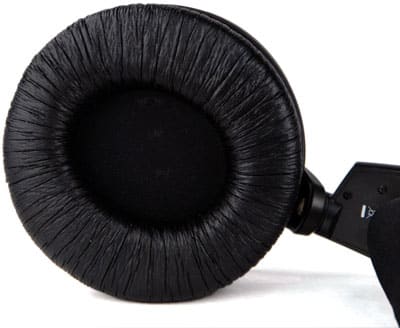
This is where the majority of the comfy is, but it doesn't make a good seal.
After our hour with the ATH-A700s, we didn't have any complaints. The padding was soft and the headphones had a looser fit than is typical. The headphones are covered in a very soft leather-print plastic. We didn't feel like they provided a very good seal with our head, but it was soft nonetheless. Part of the reason why the ATH-A700s are so comfortable is because they have such a loose fit. This means they likely won't stay on if you're moving around a lot, or banging your head excessively.
The ATH-A700s remained comfortable throughout our wear experience. They're loose enough that our heads didn't feel like squeezed grapes, but not so light and comfortable that we forgot we were wearing them. Overall, a very comfortable wear experience.
**Cable Connectivity***(11.07)*
The ATH-A700s' cord dangles from the left ear cup. It's just shy of 9 feet, 8 inches, which is long. Unless you're trying to connect to an amp that's clear across the room, the ATH-A700s' cord should be more than enough. Also, the cord has knit shielding, which should help it survive computer chair wheels and work boots.

The cord ends in a standard 1/8-inch plug, with a 1/4-inch adapter included in the box.

The ATH-A700 headphones are not portable. First of all, the things are gigantic and they don't fold. If you have to shove these in your bag, they're going to take up a lot of space. Secondly, if you're planning on taking these for a walk with your iPod, you'd better have room in your pocket for a spool of cable. There's no included form of cord management, so you'll have to supply your own rubber band or something else to bind the cord. Really, if portability is an issue for you, there are far, far better options out there: even compared to other over-ear or on-ear headphones the ATH-A700s are a pain to lug around.
There aren't many ways to customize your ATH-A700 wear experience. There aren't any cup padding replacement options, the band doesn't really extend or contract, and the ear cups don't have a particularly impressive range of motion. Really, the only customization you're offered is to help the headphones fit onto your head, and you're not so much in control of that customization as it is done for you as a by product of putting them on. We're not entirely sure if this form factor is the best for providing a customized wear experience, but it's certainly a lot less hassle then manually re-adjusting an extendable head band.
There really aren't any maintenance tools included in the box, but you can disassemble these headphones should the need arise (some people hate dust, like to resolder their connections, or simply like taking stuff apart.
First of all, you need to take off the cup padding. We thought the cups were a pain to get on and off, so bear that in mind before you go ruining the padding on your $300 headphones.
Once the pads are off, you can get an eye-full of the driver's facade.
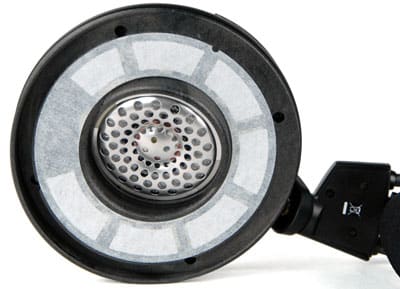
From here you can use canned air to clean out any dust that's made it past the pad.
If you wish to keep going, you'll need your tiny phillips screwdriver. Four screws later and you should see something that resembles the picture below. If you want to keep going, you can unscrew the back of the driver's housing, but chances are this is the closest you'll want to get with your canned air.
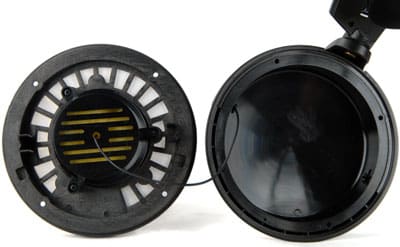
***If you dare, you can unscrew the caging on the back of the driver, but
chances are you really don't need to.***
**Other Features***(5.00)*
Battery Dependency
The ATH-A700 doesn't require batteries to run. In this, the golden age of electronic bells and whistles that don't necessarily have any great effect, not requiring batteries is fast becoming a novelty.
Value & Comparisons
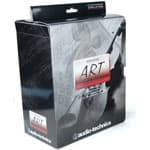
Value*(3.00)*
Like many headphones in this price range, the ATH-A700s are overpriced for what they provide you with. They aren't quite as overpriced as the Ultrasone HFI-2200 or the Bose QC3 headphones, but they're overpriced nonetheless. They have two great attributes: they're comfortable and they have far, far less distortion than we typically see. They also can isolate better than average, but that's honestly not much of a claim.
If you're looking for a good pair of in-home headphones that are comfortable to wear for a long stretch of time, you should give these a listen. Unless you really like the sound, however, there are better headphones available for less money.

[

Sennheiser HD 555](https://www.reviewed.com/headphones/content/Sennheiser-HD-555-Headphones-Review.htm) - The HD 555s will ring up a full $120 less than the ATH-A700s, and they have better audio quality to boot. The HD 555s have open backs, so they have a slightly more airy quality to their sound than the ATH-A700s do, but they also isolate far less noise. In this match-up we have to say the HD 555s are better. They're cheaper, have better quality, and are meant for the same listening environment (a quiet place with just you and your playback). They even manage to best the ATH-A700s strongest attribute: it's low distortion. Unless you love the ATH-A700s sound, the HD 555s are better.
[

Pioneer SE-A1000](https://www.reviewed.com/headphones/content/Pioneer-SE-A1000-Headphones-Review-312.htm) - The Pioneer SE-A1000s are incredibly similar to the ATH-A700s. Both are overly-expensive over-ears that require you to dress up like a religious figure. The main differences here are their strengths and price. The ATH-A700 has very minimal distortion and a bad frequency response, while the Pioneer SE-A1000 has an even frequency response but a lot of distortion. Overall, however, they have comparable audio quality and scored very similarly in other areas (other than cable connectivity: the SE-A1000s should really come with a spool for all that cable). The price may very well tip the scales, however. The Pioneer SE-A1000 headphones will offer you their comparable headphone experience for $100 less than the ATH-A700s. Again, you should really give both a listen, but the SE-A1000s give you a similar package at a significant price reduction.
[

Ultrasone HFI-2200](https://www.reviewed.com/headphones/content/Ultrasone-HFI-2200-Headphones-Review-482.htm) - The Ultrasone HFI-2200 headphones have a boomy bass. They did worse than the ATH-A700s on our audio tests, and have somewhat scratchy cloth padding. Plus, they aren't the prettiest headphones out there. This match-up goes to the ATH-A700s, for offering more at the same price point.
[

Bose QuietComfort 3](https://www.reviewed.com/headphones/content/Bost-QuietComfort3-Headphones-Review.htm) - The Bose QC3s are far better than the ATH-A700s at isolating sound, but at what price? The QC3s are a very mild version of a deal with the devil: sure you get active cancellation, but you have to be dependent on a battery and can't turn the feature off. Really, it sounds like a lame Twilight Zone episode about being careful what you wish for. The active cancellation you gain comes at the expense of $50. If you need the versatility that the cancellation brings, then the QC3s are a viable choice. If you're looking for a home theater solution where ambient noise isn't going to be much of an issue, then we'd recommend the ATH-A700s over the QC3s. They're cheaper, provide comparable audio quality, and don't require batteries.
[

Grado SR60](https://www.reviewed.com/headphones/content/Grado-SR60-Headphones-Review-235.htm) - The Grado SR60s have a nostalgaic 80s throwback aesthetic, but don't really offer up much else. They didn't do particularly well on our audio quality tests, the on-ear foam padding provides a poor seal with your ear, and the things aren't particularly comfortable either. What they are, however, is dirt cheap. You can get the SR60s for $70, which is a good price. If you're a budget shopper, they're the clear choice. If you're looking to upgrade to a nicer pair of headphones for at-home use, we'd go with the ATH-A700s. The SR60s are a better deal, but the ATH-A700s are better headphones.
Conclusion
Conclusion

The Audio-Technica ATH-A700s are above average. They have great distortion and cable connectivity, and are comfortable enough for any movie marathon. Like all over-ears, they're not particularly portable, but chances are, if you're reading this, you already knew that. Really, the ATH-A700s would be great headphones at the $200 price point. At $300, however, the ATH-A700s had better charm you with its sound, because otherwise we're not sure they're worth such a high asking price. The Pioneer SE-A1000s are very similar in terms of quality and even aesthetic. If you're looking for headphones like the ATH-A700, you should consider the SE-A1000s as well.
In summation, while the ATH-A700s are above average headphones, their price is as well.

These headphones have very little distortion, which audiophiles will definitely appreciate. Audiophiles are also likely to have some sort of ideal listening environment already assembled. We'd recommend listening first to see if the wonky frequency response is going to bug you.
These headphones are gigantic. You won't be able to drag them around with you easily.
Not only are these headphones not particularly portable, but they don't isolate well. Use in-ears or active noise cancellers on an airplane.
This is the place where the lack of isolation, prevalence of leakage, and long cord help these headphones. The low distortion means you'll get good quality, and the giant ear cups means you'll be getting a large sound stage.
Meet the tester
Mark Brezinski works on the Home Team, reviewing refrigerators, minifridges, dishwashers, washing machines, dryers, air conditioners, air purifiers, and fans.
Checking our work.
Our team is here to help you buy the best stuff and love what you own. Our writers, editors, and experts obsess over the products we cover to make sure you're confident and satisfied. Have a different opinion about something we recommend? Email us and we'll compare notes.
Shoot us an email